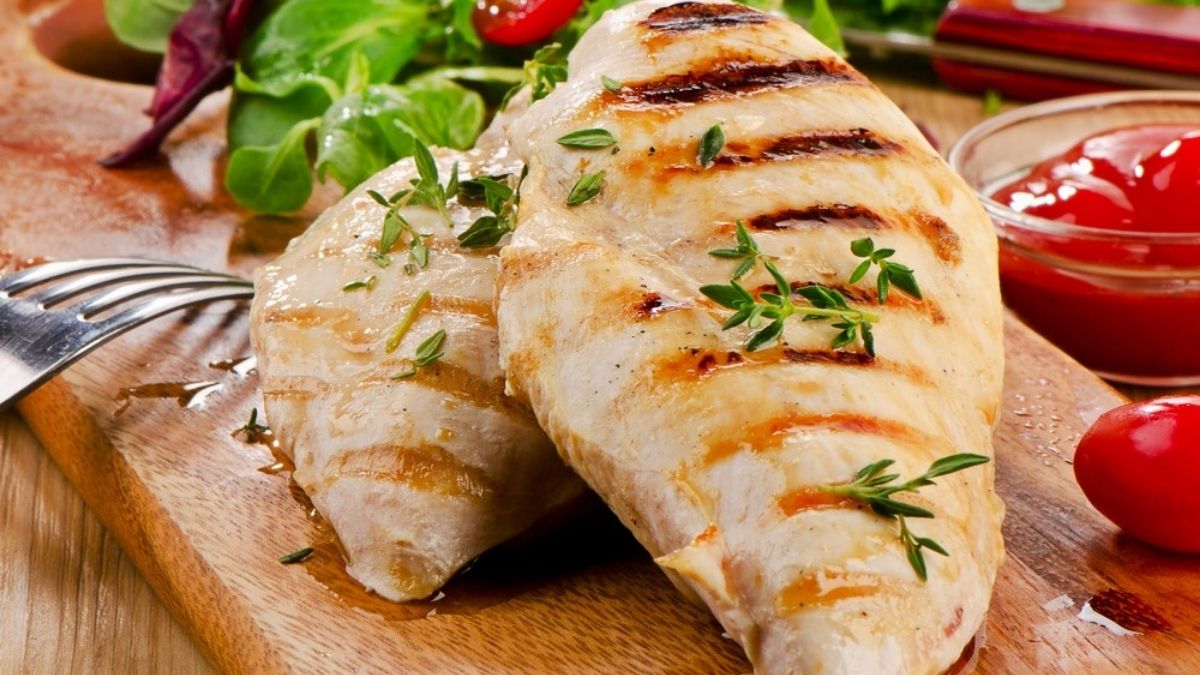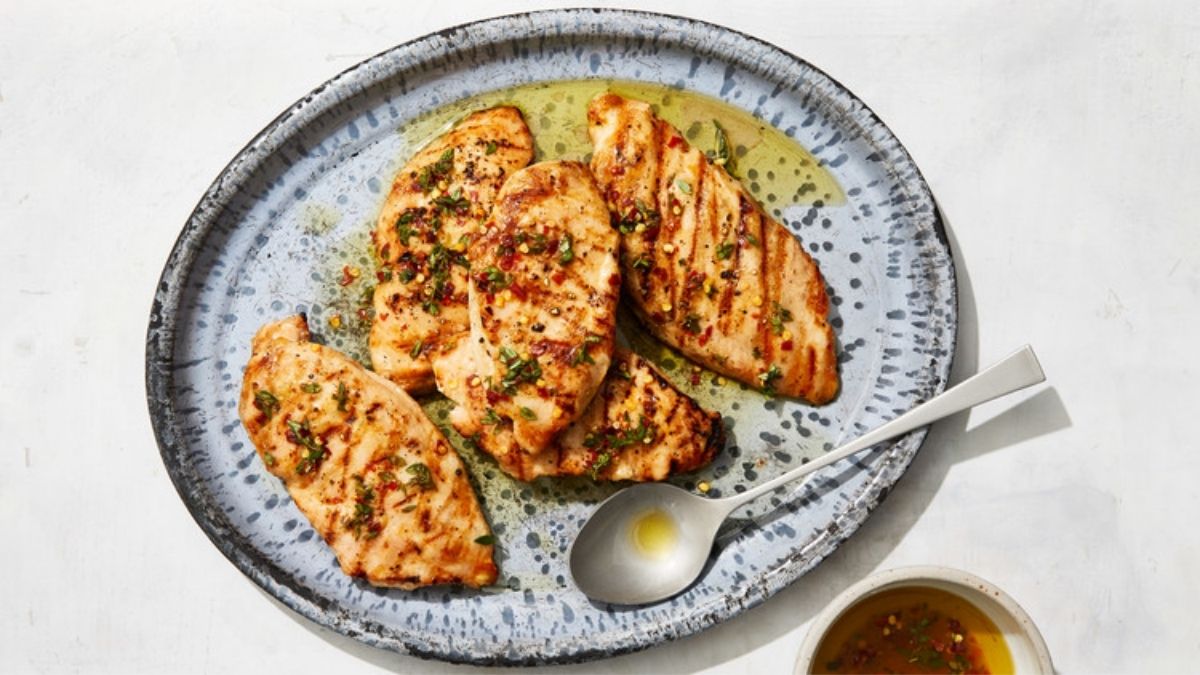You’re probably wondering how much protein is found in chicken breasts, too, and you may be wondering what kind of meat to buy. Chicken breasts come in various shapes, sizes, and protein contents. Chicken is a flexible and adaptable protein that can be prepared in various ways and eaten in various cuisines. Despite being one of the most common cuts of meat in the United States, Chicken breast is also one of the most difficult to prepare, sometimes teetering on the edge of being undercooked and dry.
What is Chicken Breast?
The chicken breast is a lean cut of meat obtained from the underside of the chicken’s pectoral muscle. Each whole chicken has one chicken breast with two halves, which are usually separated during the slaughtering process and sold separately as individual breasts. Compared to chicken thighs, wings, and drumsticks, boneless chicken breast flesh is the most expensive chicken cut due to its desired white meat and health benefits.
To prepare this versatile cut, innumerable ways include grilling, baking, roasting, frying, barbecuing, and boiling. To avoid food safety issues, the chicken should always be handled with care, and any locations, utensils, or hands that have come into contact with raw chicken should be adequately cleaned with soap and hot water.
Varieties
Pre-trimmed and ready-to-use chicken breasts are available for purchase. Chicken breasts that are frozen and individually wrapped can be found at many grocery stores and bulk warehouses. Check the nutrition information label if you buy one of these convenient solutions. These chicken breasts may have a higher salt content. You might also notice labels on chicken that say it’s organic, antibiotic-free, or something similar. These terminologies are governed by the United States Department of Agriculture (USDA):
- “Producers must demonstrate to the Agency that the poultry has been given access to the outside,” says the agency.
- Natural: “A product that has been little processed and contains no artificial ingredients or additional colours.” The term “minimal processing” refers to a method of processing that does not significantly modify the product. A statement describing the meaning of the term natural (such as “no artificial ingredients; minimally processed”) must be included on the label.
- Hormones are not permitted in the production of hogs or poultry. As a result, the claim “no hormones added” on pig or chicken labels must be accompanied by a statement that says, “Federal restrictions prohibit the use of hormones.”
- “The terms ‘no antibiotics added; may be used on meat or poultry products labels if the producer provides the Agency with sufficient documentation indicating that the animals were not reared with antibiotics.”
- Organic: To be branded organic, chickens must be raised and cared for according to strict guidelines. They must, for example, be fed 100 percent organic feed.
How Much is Protein in a Chicken Breast?
The first thing to remember is that not all chicken is created equal. Depending on which section of the bird you eat, you’ll get various quantities of protein. A typical portion of chicken is 4-5 ounces, which varies in protein content depending on whether you’re eating chicken breasts or chicken wings. We utilized the USDA FoodData Central to determine how much protein there was in each serving. When it comes to a portion of chicken, four ounces of chicken breast equals 27 grams of protein, the greatest bang for your dollars. Eating chicken breast is unquestionably the most protein-dense option for chicken.
How Much is Protein in Drumsticks, Chicken Thighs, and Chicken Wings?
The protein content of 4 ounces of chicken thigh meat (cooked with the bone removed) is 19.64 grams, similar to the chicken breast. When you eat 4 ounces of drumstick meat, which contains 17.29 grams of protein, the amount continues to decline. Chicken wings had the least quantity of protein per dish, with 13.56 grams per 4 ounces.
The protein composition of the dark meat boneless, on the other hand, changes: Boneless drumstick meat offers 27.2 grams of protein per ounce, while boneless chicken thigh meat has 25.38 grams. When it comes to protein, a skinless, cooked chicken thigh has the most, with a three-ounce serving containing about 28 grams of protein and six grams of fat. A chicken thigh contains three times more protein and about 20% less fat than a breast. For that reason, it’s an excellent choice for people looking to lose weight or gain muscle.
What your Daily Protein Intake Should be?
Yes, it is possible to consume too much protein. Each person’s recommended protein intake is different. According to the Recommended Dietary Allowance (RDA), it equals 0.8 grams of protein per kilogram of body weight. While every human body (and level of exercise) is different, a sedentary individual should consume 56 grams of protein per day for men and 46 grams per day for women.
Here’s how many 4 oz. Servings of chicken you can eat in a day, according to our estimates (on average). Consider other protein sources you’ll be eating during the day, such as cheese or yogurt, before calculating how much chicken you can eat.
What are the Health Benefits of Chicken Breast?
This type of poultry contains a lot of lean protein. Vitamin B, vitamin D, calcium, iron, zinc, and trace levels of vitamin A and vitamin C are all found in chicken. Chicken includes two to three times more polyunsaturated and monounsaturated fat than most red meats and healthier fats than those found in red meat. Chicken also has a low salt content and a low overall carbohydrate count, and it does not contain any dietary fiber.
Builds and Maintains Muscle Mass
Protein aids in the maintenance of muscle mass and the growth of muscle when used in conjunction with a strength-training regimen. 3 Studies, such as this 2016 review research, suggest that loss of muscle mass and strength is linked to higher mortality rates in the elderly.
Strengthens Bones
According to scientists and doctors, a diet substantial in animal protein was long thought to impair bone density and increase the risk of fractured bones. On the other hand, a recent study suggests that protein works in tandem with calcium to help protect bones. To maintain bones strong and healthy, you must consume adequate protein.
Reduces Appetite
Protein makes you feel full, which can help you avoid overeating and minimize food cravings. For example, a small study of overweight men on low-calorie diets discovered that those who consumed more protein had “better hunger control and satiety.”
Nutritional and Flavor Differences Between White and Dark Meat
Every chicken has two forms of meat: white and black meat, which differ in colour, flavour, and nutritional content. These differences are attributable to the type of muscle and how it is used. Dark meat originates from the chicken legs, which are regularly put to work and demand more oxygen, whereas white flesh comes from the chicken breast and wings, which receive less exercise.
Both dark and white meat chicken are high in protein and B vitamins. However, they differ in calories, fat content, and minerals. While white meat has less fat and calories than dark meat, most chicken fat is found in the skin rather than the flesh. Therefore the skin that covers portions like drumsticks and thighs is the primary source of fat and calories in dark meat chicken. Due to the improved oxygenation of those muscles, dark meat chicken is juicier and a richer source of iron and zinc.
Conclusion
The thigh has about twice as many calories as the breast in terms of calories. Besides, it’s also easier to cook chicken thighs when the skin is still on and the skin contains less saturated fat. However, chicken thigh skin contains more omega-6 fatty acids than chicken breast, increasing inflammation in the body. It’s also worth noting that chicken with the skin is not recommended for every diet, and a pair of medium chicken thighs contains 304 calories.
While thighs and breasts are low in fat and high in protein, they’re great for bodybuilders or people on a low-carb or ketogenic diet. But you should note that the breast has the most protein by weight. If you’re looking to gain weight or keep muscle mass, chicken thigh and breast contain the most protein per ounce. It’s up to you to determine what works best for your body and fitness goals.


